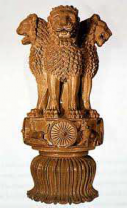4.1 Pillars

The court art of Ashoka is best seen in the white-grey sandstone columns erected by him all over his empire either to mark a sacred site associated with Buddha’s life or to commemorate a great event. On many of these pillars are inscribed the famous edicts of Ashoka propagating the Dhamma (laws of the Buddha) or the imperial sermons of Ashoka to his people.
Rising to an average height of about 40 feet, the pillars in their most
developed state, are tall, tapering monoliths with sculptured capitals,
incorporating a series of fluted petals in elongated shape, (which falling together takes the form of a bell, commonly known as the Persepolitan Bell) surmounted by a square or circular abacus ornamented with animal and floral motifs in relief. The top portion of the pillar was carved with capital figures like the bull, the lion, the elephant etc. Noteworthy are the lion capitalof Sarnath, the bull capital of Rampurva and the lion capital of Laurya Nandangarh.
These pillars were carved in two types of stone. Some were of spotted red and white sandstone from the region of Mathura, the others of buff colored fine grained hard sandstone usually with small black spots quarried in Chunar near Varanasi.The uniformity of style in the pillar capital suggests that they were all sculpted by the craftsmen from the same region.

The tradition of constructing pillars is very old and it may be observed that erection of pillars was prevalent in the Achamenian empire as well. But the Mauryan pillars are different from the Achamenian pillars. The Mauryan pillars are rock-cut pillars thus displaying the carver’s skills, whereas the Achamenian pillars are constructed in pieces by a mason.
Sarnath Lion Capital
Pillar capital and abacus with stylised lotus
The Mauryan pillar capital found at Sarnath popularly known as the Lion Capital is the finest example of Mauryan sculptural tradition. Built in commemoration of the historical event of the first sermon or the Dhammachakrapravartana by Buddha at Sarnath, the capital was built by Ashoka.
Lion Capital, Sarnath
The capital originally consisted of five component parts: (i) the shaft (which is broken in many parts now), (ii) a lotus bell base, (iii) a drum on the bell base with four animals proceeding clockwise, (iv) the figures of four majestic addorsed lions, and (v) the crowning element, Dharamchakra, a large wheel, was also a part of this pillar. However, this wheel is lying in a broken condition.The capital without the crowning wheel and the lotus base has been adopted as the National Emblem of Independent India.
The surface of the sculpture is heavily polished which is typical of the Mauryan Period. The abacus has the depiction of a chakra (wheel) having twenty four spokes in all four directions and a bull, a horse, an elephant anda lion between every chakra is finely carved. The motif of the chakra becomes significant as a representation of Dhammachkrain the entire Buddhist art.
